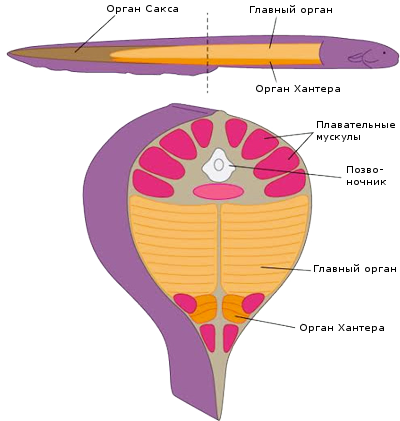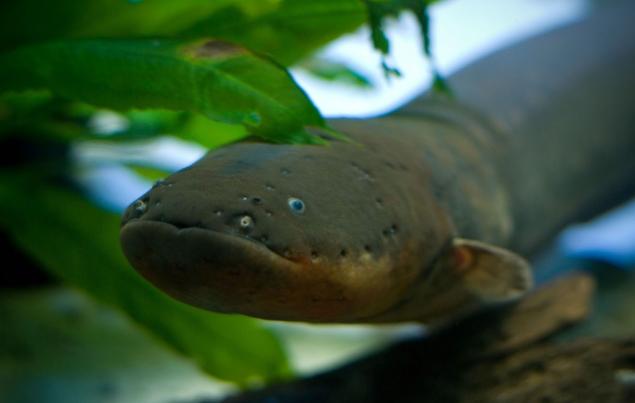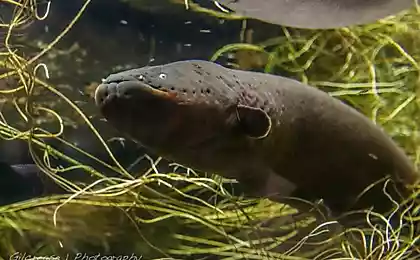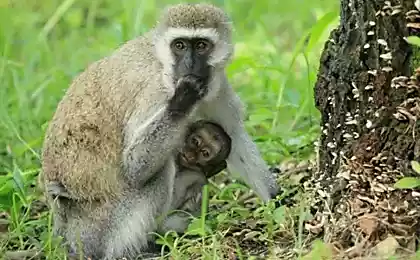905
Physics in the animal world: the electric eel and its "power station"

Electric eel (Source: youtube)
Fish species electric eel (Electrophorus electricus) - the only representative of the kind of electric eels (Electrophorus). It is found in a number of inflow of middle and lower reaches of the Amazon. Fish body size reaches 2, 5 meters in length, and weight - 20 kg. Electric eel eats fish, amphibians, if you're lucky - birds or small mammals. Scientists are studying the electric eel dozens (if not hundreds) of years, but only now have begun to clear up some of the features of the structure of his body and several organs.
Moreover, the ability to generate electricity - is not the only unusual feature of the electric eel. For example, he breathes atmospheric air. This is possible due to the large number of special type of oral tissue, permeated with blood vessels. For breathing eel should be every 15 minutes to float to the surface. Oxygen from the water, he could not take, because he lives in a very muddy and shallow waters, where very little oxygen. But, of course, the main feature of the electric eel - is its electric organs.
They play a role not only weapons to stun or kill its victims, which feeds on the eel. The discharge generated electric organs of fish, may be weak, to 10 V. These discharges eel generates for electrolocation. The fact that the fish has a special "electroreceptors", which allow to determine the electric field distortion caused by his own body. Electrolocation eel helps find your way in the muddy waters and find the hidden victims. Acne can give a strong jolt of electricity, and at that time held their fish or amphibian begins to twitch erratically due to cramps. These fluctuations in predator easily finds and eats the victim. Thus, this fish is both elektroretseptivnoy and electrogenic.

Interestingly, the level of different strengths eel generates power using three types of bodies. They occupy about 4/5 of the length of the fish. High voltage produce organs Hunter and Mena, and small currents for the purposes of navigation and communication purposes generates Sachs body. The main body and the Hunter's body placed in the lower part of the eel body, Sachs body - in the tail. Acne "communicate" with each other using electrical signals from up to seven meters. A certain series of electrical discharges, they can attract other individuals of their species.
like an electric eel generates an electrical discharge?

Acne of this species, as well as a number of other "electrified" fish reproduce electricity in the same manner that the nerves and the muscles in the bodies of other animals, just for this purpose elektrotsity - specialized cells. The task is performed by the enzyme Na-K-ATPase (incidentally, the same enzyme is important for the kind of nautilus shellfish (lat. Nautilus)). Thanks to an enzyme produced ion pump is pumping out of the cells, sodium ions, and potassium ions are pumped. Potassium is derived from the cell due to special proteins that make up the membrane. They form a kind of "potassium channel" through which potassium ions and are displayed. Inside cells accumulate positively charged ions from the outside - the negatively charged. There is an electrical gradient.
resulting potential difference is 70 mV. The membrane of the same body of the electric eel sodium and cells have channels through which sodium ions can again enter the cell. Under normal conditions, the pump 1 second outputs of cells 200 and sodium ions into the cell simultaneously carries about 130 potassium ions. On the square micrometers membrane can accommodate 100 to 200 of these pumps. Typically, these channels are closed, but if necessary, they are opened. If this happens, the chemical potential gradient causes the sodium ions that enter the cells again. There is a total change in voltage from -70 to +60 mV, and the cell gives discharge to 130 mV. The duration of the process - only 1 ms. Cells electrically interconnected by nerve fibers compound - consistent. Elektrotsity constitute original columns, which are connected in parallel already. Total power generated by the electric signal reaches 650, current - 1A. According to some reports, the voltage can reach even 1000, and current -. 2A

Elektrotsity (electric cells) under the microscope eel
After discharge again act ion pump, and electric eel bodies charged. According to some scientists, there are 7 types of membrane ion channels elektrotsitov cells. The location of these channels and channel types alternating electricity affects the production speed.
discharge electric battery
According to a study by Kenneth Catania (Kenneth Catania) from Vanderbilt University (USA), acne can use three types of discharge of its electric organ. First, as mentioned above - is a series of low-voltage pulses that are used for communication and navigation purposes
. The second - a sequence of 2-3 high-voltage pulses of a few milliseconds. This method is used when the hunt for eel hide and held his victim. Once given the 2-3 high-voltage discharge, muscle lurking victim begin to shrink, and acne can detect potential food easily.
The third way - a series of high-voltage high-frequency discharges. The third method uses an eel when hunting, issuing a second up to 400 pulses. This method virtually paralyzes any animal of small and medium-sized (even human) at a distance of 3 meters.
Who else is able to produce an electric current?
Because fish are capable of about 250 species. The majority of electricity - is only a means of navigation, such as in the case of elephant Nile (Gnathonemus petersii).
But electrical discharge sensitive force able to generate a few fish. This electric rays (number of species), electric catfish and others.

Electric catfish (Source: Wikipedia)
Jason Gellent colleagues conducted a genome sequencing of a number of fish with electric organs, and found that many of the species studied, they are not relatives. "The invention of" the nature of the electric organs of fish paralleled, but the structure of the battery is very similar at all. Total scientists counted 6 mutually independent evolutionary line that led to the emergence of electric organs. Perhaps the electric eel is a fish species that use the organ most skillfully.

Source: animalpicturesociety.com
Source: geektimes.ru/post/279576/
Autopilots vs real world: what will happen with infrastructure, morality and economics
According to scientists, a strong relationship based on just two qualities























